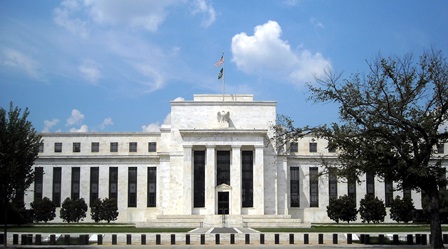In my last column, I explained why, when you're considering investment ideas, you should always keep the bond market in mind. That's because stocks and bonds are inextricably interconnected.
They're inextricably interconnected because interest rates matter.
When expected relationships between stocks and bonds (interest rates) diverge, therefore, it's important to take notice, try to understand what is happening, and consider what the divergences could portend for both stocks and bonds.
Markets are experiencing a divergence now, and a lot of analysts are getting worried.
Stocks have been moving higher as the yield on the 10-year U.S. Treasury note has been falling ("bills" have a maturity of one year or less, "notes" go up to 10 years, and "bonds" have maturities of more than 10 years).
The 10-year Treasury note is now the "benchmark" interest rate that's widely watched and viewed as a proxy for the general direction of interest rates. It's currently yielding 2.53%. That means you give the Treasury your cash, and it gives you a note that pays you 2.53% annually for 10 years, and then you get your principal back.
 When the U.S. Federal Reserve, which has been manipulating interest rates down to historic lows, said it was going to begin "tapering" its massive purchases of Treasury bills, notes and bonds, and mortgage-backed securities, the bond market got nervous. The Fed had managed rates down by exercising its quantitative easing (QE) program and announced it was paring back QE purchases because it saw the economy picking up.
When the U.S. Federal Reserve, which has been manipulating interest rates down to historic lows, said it was going to begin "tapering" its massive purchases of Treasury bills, notes and bonds, and mortgage-backed securities, the bond market got nervous. The Fed had managed rates down by exercising its quantitative easing (QE) program and announced it was paring back QE purchases because it saw the economy picking up.
(In its QE program, the Fed buys bonds from banks to flood those banks with cash in the hope that all that cash would trickle down into the economy.)
The yield on the 10-year note moved from about 2.25% to 3% in short order.
The thinking goes that if the economy is picking up it doesn't need the Federal Reserve to keep a lid on rates. That's because accelerating growth will increase demand for money and loans, which puts upward pressure on interest rates.
And letting the economy stand on its own two feet and letting interest rates rise modestly wouldn't be bad for the economy, right?
Furthermore, if interest rates rise gently, investors and businesses will take that as a sign that the economy is indeed picking up, and that will be reflected in the demand for loans and money, which ultimately shows up in rising interest rates. So, if rates are rising, things are getting better.
However, things don't look like they're working out that way. And now I'm going to tell you what actually happened and what this means for your portfolio.
Interest Rates... and a Divergence from the Expected
At the first mention of tapering, the stock market turned sour. If the Fed was cutting back its QE buying and was going to let rates rise gently, a few considerations came to light.
First, the stock market has risen because interest rates have been artificially low. Cheap money, which allows investors and speculators to borrow at low rates to leverage up their positions, moves stocks higher, because more shares can be bought.
And when interest rates are inordinately low, stocks become a more viable investment alternative, on account of cheap money coming in to buy shares and because dividend yields on a lot of stocks pay considerably more than bills, notes, and bonds. Their yields are being held down.
With the beginning of the end of the Fed's interest-rate manipulation on the horizon, stocks sold off. After all, if the economy was getting better, rates were going to rise, and stocks were at all-time highs, how much further might they go if the boost they had gotten for years was being tapered back?
Then the divergence showed up.
The 10-year yield began to fall, while stocks regained ground and made another run higher.
As far as divergences go, and there are many relationships that sometimes diverge, this one grabbed a lot of attention.
Why was the yield on the 10-year going down and not up if the Fed was tapering, if the economy was getting better? And why were stocks going up?
Here's what's worrisome.
The 10-year yield goes down because investors are buying the notes. Why are investors rushing into government notes and bonds?
One theory is that there's a "flight to quality" going on. Big institutional investors are nervous because they think there's something wrong somewhere and they want to get into the safest trades.
Maybe there are macro fears, like fear that Russia will start a war, or that Iran will stir up trouble, or Syria will implode further, or Thailand will foster regional nervousness. Any number of worrisome global macro events might cause investors to run to safe investments.
Maybe Europe is heading into its third recession in the past five years? Maybe China's credit bubble will pop and cause a global panic?
Or, maybe the U.S. economy isn't getting better, and there won't be demand for loans and money. Maybe, after a miserable first-quarter GDP number, we're looking at another recession, more disinflation, and maybe deflation. Maybe investors are afraid of that and are buying notes and bonds now before their yields fall further.
Maybe investors are concerned that stocks have risen too far and if the economy isn't picking up their high prices won't be justified?
This divergence - yields dipping when they were expected to rise and stocks rising when they were expected to dip - is what has analysts and investors nervous.
Of course, I'm watching this divergence, and you should be, too.
No one knows for sure what this divergence is signaling, or whether it will self-correct, and what that correction will mean for stocks and bonds. But one thing's for sure: We all better keep a close eye on the stock market and the bond market.
Today's Top Investing Story: Many investors believe that with our presence in Iraq largely gone, defense tech firms will offer mediocre returns at best. But they couldn't be more wrong. This defense tech play is scorching the market...
About the Author
Shah Gilani boasts a financial pedigree unlike any other. He ran his first hedge fund in 1982 from his seat on the floor of the Chicago Board of Options Exchange. When options on the Standard & Poor's 100 began trading on March 11, 1983, Shah worked in "the pit" as a market maker.
The work he did laid the foundation for what would later become the VIX - to this day one of the most widely used indicators worldwide. After leaving Chicago to run the futures and options division of the British banking giant Lloyd's TSB, Shah moved up to Roosevelt & Cross Inc., an old-line New York boutique firm. There he originated and ran a packaged fixed-income trading desk, and established that company's "listed" and OTC trading desks.
Shah founded a second hedge fund in 1999, which he ran until 2003.
Shah's vast network of contacts includes the biggest players on Wall Street and in international finance. These contacts give him the real story - when others only get what the investment banks want them to see.
Today, as editor of Hyperdrive Portfolio, Shah presents his legion of subscribers with massive profit opportunities that result from paradigm shifts in the way we work, play, and live.
Shah is a frequent guest on CNBC, Forbes, and MarketWatch, and you can catch him every week on Fox Business's Varney & Co.



